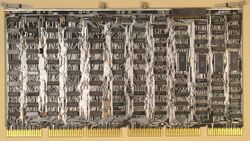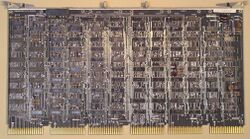Difference between revisions of "KD11-EA CPU"
(details of OYY connector) |
(Note different machine designation) |
||
| Line 1: | Line 1: | ||
[[Image:KD11-EA M8265.jpg|250px|right|thumb|M8265 Data Paths card]] | [[Image:KD11-EA M8265.jpg|250px|right|thumb|M8265 Data Paths card]] | ||
| − | The '''KD11-EA CPU''' was the | + | The '''KD11-EA CPU''' was the [[Central Processing Unit|CPU]] for the [[PDP-11/34A]] version of the [[PDP-11/34]]; it consisted of two [[DEC card form factor|hex]] [[printed circuit board]]s, the M8265 Data Paths module and the M8266 Control module. |
| − | + | The KD11-EA also supported the optional [[FP11-A Floating-Point Processor|FP11-A]] [[floating point]] ([[FP11 floating point]] type) unit and/or the [[KK11-A Cache Memory|KK11-A]] [[cache]] (it could work with either, or both). | |
Apparently, the [[microcode]] [[address space]] was increased by one bit in the KD11-EA over the [[KD11-E CPU]], probably to support the extra microcode needed for the [[floating point]] [[instruction]]s. | Apparently, the [[microcode]] [[address space]] was increased by one bit in the KD11-EA over the [[KD11-E CPU]], probably to support the extra microcode needed for the [[floating point]] [[instruction]]s. | ||
Revision as of 11:37, 19 April 2021
The KD11-EA CPU was the CPU for the PDP-11/34A version of the PDP-11/34; it consisted of two hex printed circuit boards, the M8265 Data Paths module and the M8266 Control module.
The KD11-EA also supported the optional FP11-A floating point (FP11 floating point type) unit and/or the KK11-A cache (it could work with either, or both).
Apparently, the microcode address space was increased by one bit in the KD11-EA over the KD11-E CPU, probably to support the extra microcode needed for the floating point instructions.
FP11-A/KK11-A installation
Adding either the FP11-A or KK11-A is fairly simple (provided there is adequate power available); they are plugged into the CPU's DD11-P backplane in the slot next to the two CPU boards, and special over the top (OTT) connectors in the form of small PCB cards bearing Berg connectors plug into Berg headers on the two neighbouring cards to connect them up.
(It is not clear why DEC adopted a design which used the OTT cards, although avoiding them would have required the more-expensive upgrade path of a new backplane; there may also not have been enough spare pins on the edge connectors.)
The KK11-A needs only an H8821 two-connector OTT card (40-pin connectors, although the ones used in the H8821 also have 2 blank pins on each end, i.e. the physical form is that of a 44-pin), which goes from the KK11-A to the M8265 card of the CPU.
The FP11-A needs both an H8821, and also the smaller 54-12416 two-connector OTT card, which goes from the M8266 card of the CPU to the FP11-A (28-pin connectors, although 2 pins on each end, and 4 in the centre, are blocked off).
If both an FP11-A and a KK11-A are plugged in, things become slightly more complex. The FP11-A has to be mounted in the slot next to the CPU boards, and the KK11-A has to be mounted in the second slot up from that one.
(The KY11-LB Programmer's Console is mounted in the slot in the middle; as far as is known, there is nothing special about that slot, and the KY11-LB could just have been moved over one slot, but DEC must have decided that the documentation would be simpler if it were always in the same slot.)
Instead of the two-connector H8821 OTT card, the very similar H8822 OTT card, with three connectors, must be used instead.
KY11-LB Interface
Like the KD11-E, it also supported the KY11-LB Programmer's Console, including the diagnostic functionality which allowed the CPU's microcode to be single-stepped.
The interface to the KY11-LB was carried over two 10-wire flat cables connected to Berg connector headers (denominated J1 and J2) on the M8266 module. The pinout for P1 is the same as for the KD11-E; P2 has additional signals (other than μPC08) added in the KD11-EA, though:
J2:
- Micro-PC 08
- FP11-A Attached
- Unused
- Unused
- Unused
- Micro-PC 09
- Service Br Power Fail
- Load Instruction Register
- Power Fail Br Pending
- Unused
See also
| v • d • e PDP-11 Computers and Peripherals |
|---|
| UNIBUS PDP-11s - PDP-11/20 • PDP-11/15 • PDP-11/35 • PDP-11/40 • PDP-11/45 • PDP-11/50 • PDP-11/55 • PDP-11/70 PDP-11/05 • PDP-11/10 • PDP-11/04 • PDP-11/34 • PDP-11/60 • PDP-11/44 • PDP-11/24 • PDP-11/84 • PDP-11/94 QBUS PDP-11s - PDP-11/03 • PDP-11/23 • PDP-11/23+ • MicroPDP-11/73 • MicroPDP-11/53 • MicroPDP-11/83 • MicroPDP-11/93 QBUS CPUs: LSI-11 • LSI-11/2 • KDF11-A • KDF11-B • KDJ11-A • KDJ11-B • KDJ11-D • KDJ11-E Buses: UNIBUS • UNIBUS map • SPC • MUD • EUB • QBUS • CD interconnect • PMI Also: PDP-11 architecture • PDP-11 Extended Instruction Set • FP11 floating point • PDP-11 Memory Management |
| UNIBUS CPUs: KA11 • KC11 • KB11-A • KB11-B • KB11-C • KB11-D • KD11-A • KD11-B • KD11-D • KD11-E • KD11-EA • KD11-K • KD11-Z • KDF11-U
Co-processors: FP11-A • FP11-B • FP11-C • FP11-E • FP11-F • KE44-A • FPF11 Chips: LSI-11 • KEV11-A • KEV11-B • KEV11-C • F-11 • KEF11-A • KTF11-A • T-11 • J-11 • FPJ11 CPU options: KE11-E • KE11-F • KJ11-A • KT11-C • KT11-D • KK11-A • KK11-B • KT24 • KTJ11-B Rare CPU options: KS11 Memory Protection and Relocation option • KT11-B Paging Option • KUV11 Writeable Control Store Front panels: KY11-A • KY11-D • KY11-J • KY11-LA • KY11-LB • KY11-P More on buses: UNIBUS and QBUS termination • Bus Arbitration on the Unibus and QBUS • CTI BUS PDT-11s - PDT-11/110 • PDT-11/130 • PDT-11/150 CTI PDP-11s - PRO-325 • PRO-350 • PRO-380 Other: FIS floating point • PDP-11 Commercial Instruction Set • PDP-11 stacks • PDP-11 family differences |

